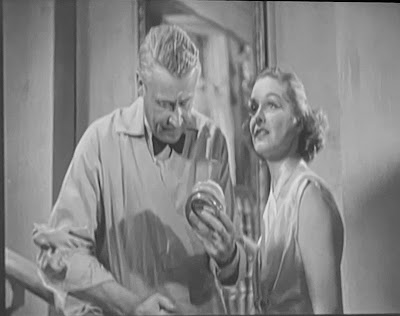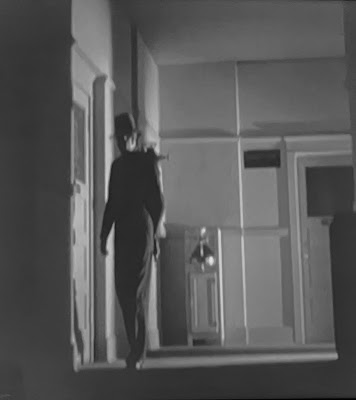I recently picked up and flipped through my copy of William K. Everson's classic A Pictorial History of the Western Film, as one does when escaping the heat of an Alabama summer day. What did I find but a couple of stills and some discussion of Johnny Mack Brown's role as William Bonney in the 1930 film Billy the Kid. Let's investigate.
Thursday, September 21, 2023
Johnny Mack Brown as Billy the Kid
Friday, September 15, 2023
Gail Patrick in "The Preview Murder Mystery"
One of the topics I bring out from time to time on this blog is film actresses from the state whose careers began before 1960. I've covered some others after that date, too, but today's post fits that group.
One of those pre-1960 actresses is Birmingham native Gail Patrick. A career overview I posted in 2015 is here. In 2019 I wrote about her role as a private detective [really!] in Murder at the Vanities, a truly bonkers 1934 pre-code film. In 2020 I posted about her post-acting career as Executive Producer on the classic Perry Mason TV series and her appearance in the final episode. In 2021 I wrote about her role as the femme fatale in The Maltese Falcon--a radio version, but still....
Now we come to her role in The Preview Murder Mystery from 1936. I watched this one recently on TCM and really enjoyed it. There's a rather interesting framing device--it's a movie about the making of a movie and features quick action, witty dialog and some murders. Director Robert Florey would helm over 50 movies and numerous episodes of TV shows in his long career. By the time he made this one, he had already directed such classics as the Marx Brothers first feature, The Cocoanuts [1929] and Murders in the Rue Morgue [1932].
The film being filmed is "Song of the Toreador", and we get to see some extensive scenes in its preview screening. We also see even longer scenes involving the filming process, so that the cast and crew of "Toreador" are much of the cast and crew of Preview. Very meta. "Song" is a remake of a silent film starring the late husband of Patrick's character, Claire Woodward Smith.
A lot of this film's snap, crackle and pop is courtesy of the performances by and dialog written for Reginald Denny and Frances Drake as they play the studio publicity head and his secretary. A running gag is Denny's constant proposals of marriage, and refusals by Drake, whose character is an astrology nut and keeps telling him the stars are not aligned properly.
Catch this movie if you have a chance. It's only an hour long and is available on YouTube.
Some more comments are below.
Friday, September 8, 2023
Birmingham Photo (86): Joiner Furniture Company
I stumbled across this photograph as I wandered around the Alabama Mosaic web site. As the site notes, "Alabama Mosaic is a repository of digital materials on Alabama's history, culture, places, and people. Its purpose is to make unique historical treasures from Alabama's archives, libraries, museums, and other repositories electronically accessible to Alabama residents and to students, researchers, and the general public in other states and countries." I've certainly found a lot of goodies there over the years.
The bit of research I did on the Joiner Furniture Company produced very little information. According to the source of the photo, the Birmingham Public Library Digital Collections, it was taken in 1930 and shows the store at 1716 2nd Avenue North. According to BhamWiki, the six story structure is now known as the Jefferson Home Furniture building and was constructed in 1915. The J.E. Cain Furniture company operated there in the 1920's followed by Joiner. Duke Brothers Furniture took over in 1945 and then Jefferson Home, which remodeled it in the 1960s. More recent efforts to convert the building to lofts or self-storage were unsuccessful.
Below the photograph is a portion of the "Furniture" section of the 1945 Birmingham Yellow Pages. Ironically, Joiner's entry follows Jefferson's, its eventual replacement in the building.
At the lower left in the picture can be seen the marquee of Joiner's neighbor, the Jefferson Theatre. Opened in 1900 as a vaudeville house, the theater closed in the Great Depression and was demolished for a parking lot in 1946.
I can't make out the sign in the lower right of the photo.
One final note: look at all those cool cars!
Thursday, August 31, 2023
Louise Fletcher in "Bat Masterson"
Oscar-winning actress and Birmingham native Louise Fletcher had a long career in film and television before her death in September 2022. Among her many performances were an Oscar-winning turn for Best Actress as Nurse Ratched in the 1975 film One Flew Over the Cuckoo's Nest and several appearances as a religious leader in the Star Trek: Deep Space Nine series from 1993 until 1999. Despite her many years in Hollywood and her last years in France, she maintained a connection with the Episcopal church in Birmingham where her father served as rector.
Thursday, August 24, 2023
Alabama Photos: Langdon Hall at Auburn University
One of Auburn University's most prominent older buildings is Langdon Hall on South College Street. I remember it well from my student days at AU in the early 1970s. I watched films there and heard visiting speakers on several occasions.
The building was constructed in 1883; the architect was W.P. Wood, an 1881 alumnus of the university. The auditorium was remodeled in 1950, and Langdon is now used as an auditorium and personnel office.
The structure was named after Charles Carter Langdon (1805-1889), a Mobile cotton broker, newspaper editor and mayor. He was also an Auburn trustee from 1872 until his death. Fellow trustees named the building Langdon Hall after his death.
Source: Alabama Dept of Archives and History
Langdon Hall in 1897
Source: Alabama Dept. of Archives and History
Source: Auburn University
Thursday, August 17, 2023
Bees Making Honey Down in Sunny Alabam' .
I've done a few posts on this blog about songs and music related to Alabama. Two such pieces on songs from the 19th and early 20th centuries can be found here and here. I've written an item on three pretty obscure albums by state musicians. I also wrote an extensive post on songs featuring Birmingham. I recently came across another relevant early 20th century song, so here we are.
Thursday, August 10, 2023
My Son Amos Has a New Book Out, Part 2!
Our son Amos Jasper Wright IV is an urban planner by profession, but he has been writing and publishing fiction for some years. In 2018 his collection of short stories Nobody Knows How It Got This Good was published by Livingston Press. This summer his first novel, Petrochemical Nocturne, has appeared, also published by Livingston.
When Nobody Knows came out, I naturally wrote a blog post about it. The Kirkus review of the book is here. An interview with him about the book is here. In October 2018 Amos appeared on a panel alongside two other writers with new short story collections at the Louisiana Book Festival in Baton Rouge.
So here we are with Amos' first novel, Petrochemical Nocturne. Kirkus has reviewed this title, and so has Bill Plott for the Alabama Writers Forum. Bradley Sides interviewed Amos for the Alabama Writers Cooperative. Once again Amos will be appearing at the Louisiana Book Festival.
Both books are available from Bookshop.org, a book vendor where every purchase supports independent bookstores. The link for Petrochemical is here and Nobody Knows is here.
If you have read or do read either of these books, please go to their GoodReads pages, say a few words, and rate the book. In the first paragraph above the books' titles link to those pages. Of course, if you buy from Amazon or other outlet, reviews there would be greatly appreciated. And you can always request that your local library purchase one or both titles.
"A bristling, lurching, and often insightful investigation of the past." Says Kirkus about Petrochemical
In his review, Bill Plott wrote about the novel, "Although a novel, this is also an extraordinary work of history. Using Cancer Alley as a setting, Wright has penned a book that is essentially about racism – the systemic and pervasive racism of not just the South but also the nation. Perhaps no white historian has told it with quite the passion that Wright brings to the table."














































